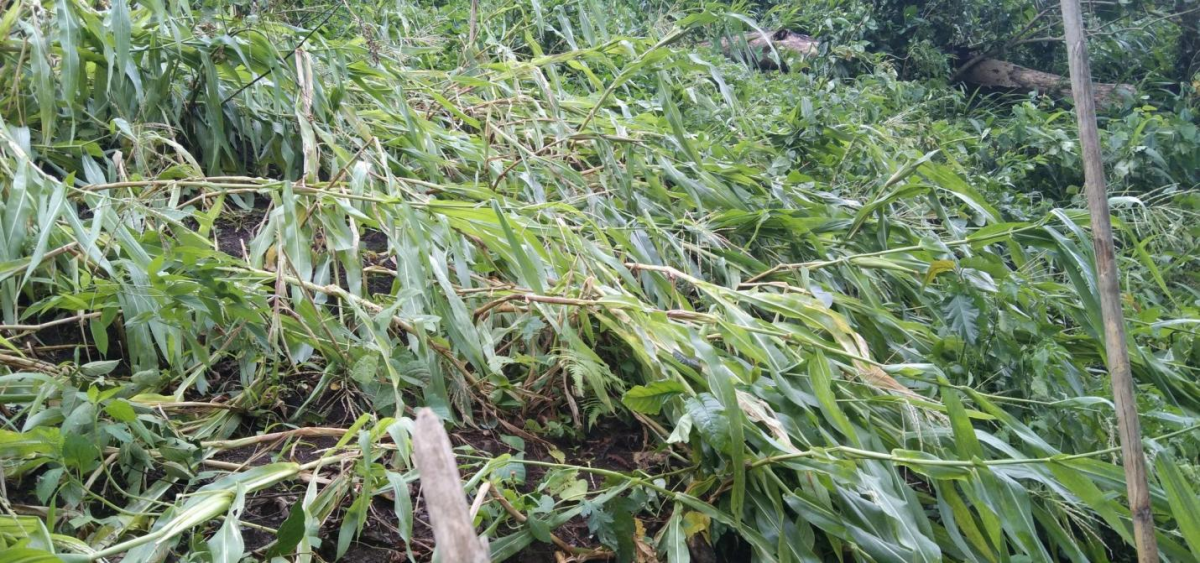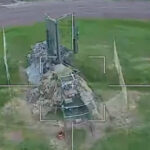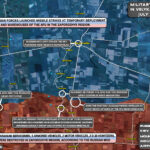By Sagip Kanayunan
Criminal negligence amid climate emergency
President and agriculture secretary Bongbong Marcos Jr is maintaining a business-as-usual stance on the effects of supertyphoon “Egay” and harping on “Filipino resiliency” to mask his inefficiency and negligence in times of calamity. The widespread damages further expose the government’s continued policy of neglect in terms of disaster preparedness and response in the face of the changing climate and extreme weather events.
Super typhoon “Egay” (international name: Doksuri) ripped through the northern Philippines last week and left most of Luzon island in a state of calamity. More than a week of heavy rains intensified the southwest monsoon (Habagat), resulting in torrential rains, massive flooding, landslides, and serious damage to agriculture and infrastructure.
Widespread flooding was observed in northwestern mainland Cagayan, Ilocos Norte, Abra, and Ilocos Sur, while multiple landslides hit Mountain Province, Abra, and Benguet. Days after “Egay” exited the Philippine area of responsibility, many towns in Bulacan and Pampanga remain submerged in flood. Millions of Filipinos are still in need of urgent relief — food, water, medicines, and emergency shelter. They will also be needing significant long-term rehabilitation assistance for their damaged houses, destroyed crops, damaged fishing boats, and means of livelihood swept away in the flood.


“Egay”, declared so far as the eighth most destructive tropical cyclone in the last five years, has affected more than 3 million persons across 14 regions, 51 provinces, and 469 cities and municipalities nationwide. As of August 5, the death toll reached 29 individuals.
The domestic agriculture sector has so far sustained the largest loss. As of August 5, “Egay” wiped out P4.47 billion worth of agricultural crops including rice, corn, vegetables, fisheries, livestock, and poultry, among others. The Department of Agriculture (DA) reported that the typhoon affected 170,510 farmers and fishers with the total volume of production loss estimated at 152,041 metric tons spanning 195,539 hectares of agricultural areas.
Rice incurred P1.75 billion in losses with the affected area at 111,547 hectares and the volume of production loss at 42,754 MT. For corn, the damage totaled P1.74 billion, affecting 95,658 MT of produce on 81,998 hectares of land. However, the actual damages and the number of affected farmers and fishers could be higher.
Damage in Marcos Jr’s Ilocandia
Marcos Jr was in Malaysia on July 26 when “Egay” ravaged his home province of Ilocos. Said to be the second-strongest typhoon to hit Ilocos since 1967, the typhoon dumped a month’s worth of rain in Ilocos Norte and Ilocos Sur in a period of 48 hours, instantly inundating many areas and even damaging the iconic Quirino Bridge that connects Vigan City to nearby towns. Swathes of cornlands were submerged, and many farm animals drowned in the flooding. A surge in the prices of commodities was observed in typhoon-hit areas.

In La Union, rice lands across Aringay town were destroyed while corn crops in upland areas were flattened. The flooding also caused the overflowing of fishponds. The Naguilian Bridge almost collapsed due to strong winds, forcing residents to cross the river via makeshift water rafts. While electricity was restored in the province last August 1, flooding has not yet subsided in many areas. Local LGUs have started distribution of food packs but it is not enough for all the affected residents.
While Marcos Jr promised to provide more than P120 million in aid for Ilocos Sur, Ilocos Norte, La Union, and Pangasinan provinces from the Office of the President’s Socio-Civic Projects Fund, residents attest that the trickle-down of assistance is extremely slow and selective.
Typhoon-ravaged Cagayan and Cordillera regions
The provinces of Cagayan and Isabela have weathered one too many super typhoons in the past several years. While the four new Marcos Jr-approved EDCA sites in the said provinces were claimed to boost disaster response, farmers say otherwise.
Nonstop rains led to the swelling of the Abulug River. The Cagayan River breached its critical level, flooding many of its tributaries. Residents were forced to seek refuge in higher grounds and many were trapped on roofs as floods ravaged many towns across the province.
Extensive damage to agriculture particularly to corn, rice, and other crops was reported by farmers. Corn farmers are suffering back-to-back economic losses due to successive extreme weather events. The corn crops which they previously planted dried up due to dry spells and lack of rain last March to May. The new corn crops they recently planted were flattened and deluged in flood due to heavy rains brought by “Egay” and Habagat. In Ilagan town in Isabela, newly-planted palay incurred damages of up to 50% to 90 percent.

Paltry government relief has not reached the majority of typhoon victims. Farmers noted that while LGUs are providing food packs, the assistance is only limited to residents and families staying in evacuation centers. Farmers and fishers have yet to receive any aid from the local DA while fishpond owners are seeking assistance for their damaged fish pens.
Before “Egay” hit, local rice and corn farmers in Region 2 provinces of Cagayan, Isabela, Quirino, and Nueva Vizcaya were promised one sack each of seeds and fertilizer as part of the LGUs distribution of 125,000 bags of urea fertilizer for rice and 3,000 bags of corn seeds in time for the wet planting season. Many have not yet received the said assistance and the LGU insists that the DA should distribute vegetable seeds for food consumption to replace rice and corn farming.
Serve the People Brigade in Cordillera said “Egay” also wreaked havoc in the region’s six provinces. The super typhoon triggered landslides and mudslides. Corn crops in Balbalan, Kalinga were destroyed. Rice fields were buried in mud and rocks in Binasaran, Abra. Even organic farms and greenhouses were destroyed, affecting vegetable and fruit crops. Farmers were readying to harvest their produce when the typhoon struck.
Vast rice fields were also submerged in floods in Pangasinan, Aurora, Mindoro Occidental, and Rizal provinces, instantly pushing upward the retail prices of rice in NCR and nearby provinces by up to P2 per kilo.
Damage to fisheries, effects of reclamation
Pampanga’s fisheries sector was also severely hit by “Egay” after fishponds overflowed. In Cavite province, more than 7,000 fisherfolk were unable to go fishing for almost two weeks due to gale warnings. Based on initial data gathered by Pamalakaya-Cavite, the successive typhoons and Habagat have affected: 1,046 fisherfolk in Noveleta; 1,500 in Bacoor City; 2,000 in Rosario; 150 in Cavite City; and 2,500 in Tanza town. Pamalakaya said the flooding incidents in parts of Bulacan and Pampanga should prompt the DENR to temporarily put on hold ongoing reclamation projects in Manila Bay until proponents scientifically prove that their projects have not aggravated the flooding hazards in coastal areas.
Urgent demands of farmers and fishers
Farmers and fishers said they are justified in demanding urgent relief and substantial rehabilitation. They said the LGU distribution of food and relief packs should be for all typhoon victims including residents who are not in evacuation centers, and immediate assistance should also be granted even for farmers and fishers who are not registered with the DA’s RSBSA.
Among the most urgent demands of farmers and fishers to the DA and the government are the following:
- Grant P25,000 cash aid to farmers whose farms and crops were either damaged or destroyed and to fishers who were not able to go fishing in the past weeks due to Egay and Habagat.
- Aid for farmers whose farm animals (cows, carabaos, etc.) drowned in the flooding.
- Emergency shelter assistance for farmers and fishers whose houses were damaged and destroyed.
- Price freeze and price ceiling on rice, vegetables, poultry, livestock, and other basic commodities in the Price Act.
- Stop the weekly oil price hikes and remove the excise tax on oil products.
- Immediate release and distribution of the Rice Farmers Financial Assistance or P5,000 each for 2.4 million rice farmers.
- Transform the Agricultural Competitiveness Enhancement Fund (ACEF) collected from import tariffs,
to direct agricultural subsidies for small farmers and fisherfolks.
What you can do to help?
KMP leads its own Sagip Kanayunan relief and rehabilitation drive for farmers and fishers affected by recent calamities. Let us pool resources and send immediate aid to typhoon-stricken communities of Ilocos, Cordillera, Central Luzon, and Cagayan Valley regions. Help #SagipKanayunan send relief packs and cash donations to farmers, fishers, agricultural workers, and rural poor severely affected by catastrophic flooding that led to the loss of livelihood.
You may send cash donations to Sagip Kanayunan via GCASH 09476191212 and via PayPalme/peasantph.

For more details on how to donate or volunteer, visit https://web.facebook.com/sagipkanayunan. ###
Photos from Danggayan-CV, Serve the People Brigade-Cordillera, and news reports.



